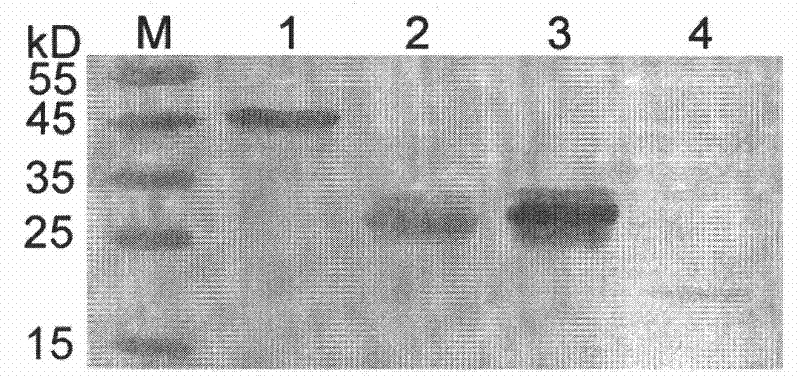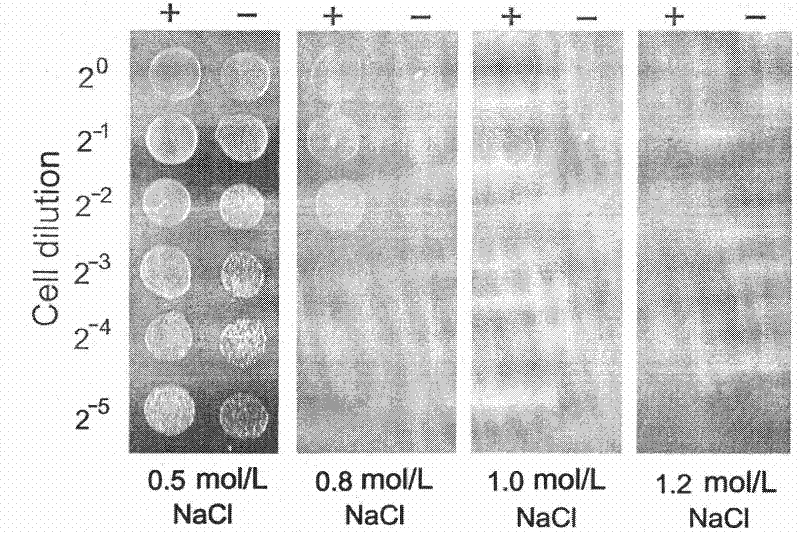Physarum polycephalum stress-inducible protein 1 (PSTI1) for improving stress resistance of prokaryote and application of PSTI1
A prokaryotic and stress-resistant technology, which is applied in the field of improving the stress resistance of prokaryotes, and can solve problems such as the undiscovered STI1 protein
- Summary
- Abstract
- Description
- Claims
- Application Information
AI Technical Summary
Problems solved by technology
Method used
Image
Examples
Embodiment 1
[0047] Example 1: Isolation of complete cDNA of PSTI1
[0048] Referring to Daniel et al. [28] The method suspension culture Physcoma polycephalum (p.polycephalum PpII (+ / -)) bacterial strain, this bacterial strain is donated by Institute of Biophysics, University of Regensburg, Germany, and can also be purchased from the American Type Culture Collection (preservation number ATCC NO: 24467), or purchase the strains of Phymophora polycephalum from commercial companies, such as Promega, Invitrogen, etc.
[0049] Take 100 mg (wet weight) of Physomum polycereus microplasma, and use RNeasy Plant Mini Kit (QIAGEN, Germany) to extract total RNA. with GeneRacer TM Kit (Invitrogen, USA) prepared mRNA containing 5'-cap structure into complete cDNA. According to the 3′-cDNA sequence of PSTI1, two generacer TM The downstream PCR primers R1 and R2 required by Kit (see Table 1). Use the primers in Table 1 for GeneRacer TM 5′Primer / R1 and GeneRacer TM 5'Nested Primer / R2, namely th...
Embodiment 2
[0056] Example 2: Recombinant expression of PSTI1 and its functional domains TPR1 and TPR2
[0057] Using the complete cDNA as a template, use the primer pair psti1-F / psti1-R in Table 2 to clone the gene encoding PSTI1. The PCR product was inserted into the BamH I and Sal I restriction sites of the vector pET-32a (+) (Novagen, the U.S.), and the recombinant plasmid pET-psti1 was cloned in E.coliTop10 (Invitrogen, the U.S.):
[0058] Extract the plasmid pET-psti1 and transform it into E.coli Origami TM (DE3) (Invitrogen, USA), positive transformant PSTI1(+) was screened on an LB culture plate containing 50 μg / ml Amp and 30 μg / ml Kan to obtain recombinant plasmid pET-psti1.
[0059] Using pET-psti1 as a template, clone the PSTI1 conserved peptide TPR1 (15- 107aa) and TPR2 (135-233aa) gene fragments tpr1 and tpr2, and recombined into the vector pET-32a(+), to prepare plasmids pET-tpr1 and pET-tpr2.
[0060] Then transform E.coli Origami separately TM (DE3), prepared as transfor...
Embodiment 3
[0064] Embodiment 3, Western Blot test
[0065] Culture PSTI1(+), TPR1(+), TPR2(+) and PSTI1(-) in LB medium to OD 600 =0.5-0.6, add IPTG at a final concentration of 1 mmol / L and continue to culture for 4 hours (30°C) to induce the expression of Trx-fused PSTI1, TPR1 and TPR2.
[0066] Take 1ml of the bacterial liquid and mix it with an equal volume of 2×loading buffer and boil it for 10 minutes, then take the supernatant and perform SDS-PAGE on a 12% polypropylene gel. After the protein in the polypropylene gel was transferred to the nitrocellulose membrane, it was blocked overnight with skimmed milk powder, and detected with mouse anti-Trx Tag polyclonal antibody (ABGENT, USA) and alkaline phosphatase-labeled goat anti-mouse IgG (Proteintech, USA) Trx, Trx-PSTI1, Trx-TPR1 and Trx-TPR2 [use BCIP / NBT (Bromo-Chloro-Indolyl Phosphate / NitroBlue Tetrazolium) as the chromogenic substrate].
[0067] The molecular weight of Trx is 17kD, and the theoretical molecular weights of Trx-...
PUM
 Login to View More
Login to View More Abstract
Description
Claims
Application Information
 Login to View More
Login to View More - R&D
- Intellectual Property
- Life Sciences
- Materials
- Tech Scout
- Unparalleled Data Quality
- Higher Quality Content
- 60% Fewer Hallucinations
Browse by: Latest US Patents, China's latest patents, Technical Efficacy Thesaurus, Application Domain, Technology Topic, Popular Technical Reports.
© 2025 PatSnap. All rights reserved.Legal|Privacy policy|Modern Slavery Act Transparency Statement|Sitemap|About US| Contact US: help@patsnap.com



